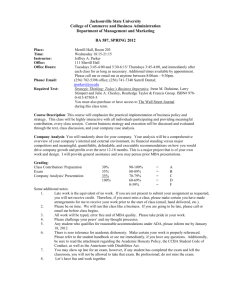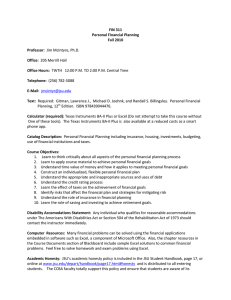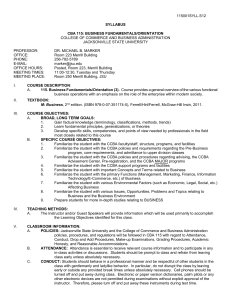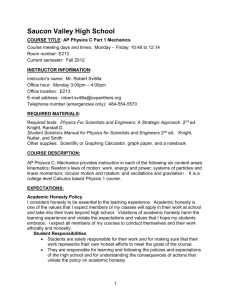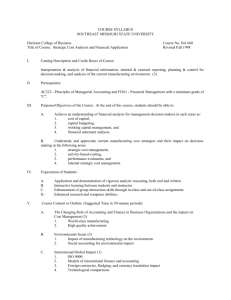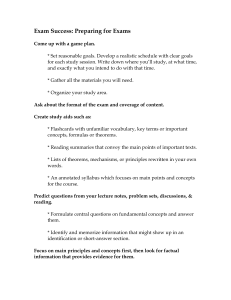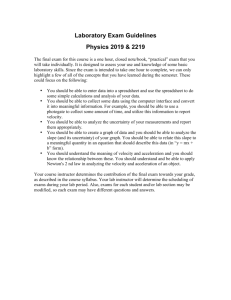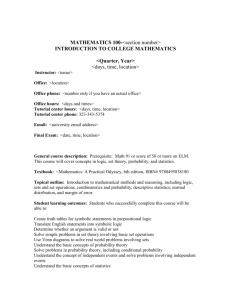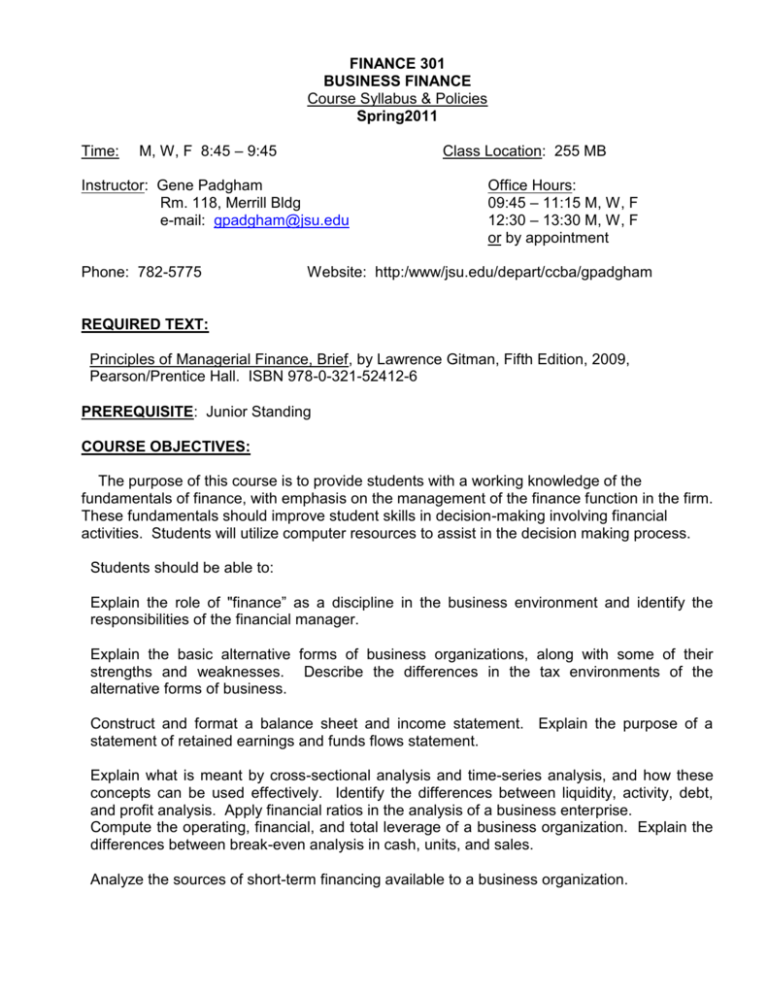
FINANCE 301
BUSINESS FINANCE
Course Syllabus & Policies
Spring2011
Time:
M, W, F 8:45 – 9:45
Class Location: 255 MB
Instructor: Gene Padgham
Rm. 118, Merrill Bldg
e-mail: gpadgham@jsu.edu
Phone: 782-5775
Office Hours:
09:45 – 11:15 M, W, F
12:30 – 13:30 M, W, F
or by appointment
Website: http:/www/jsu.edu/depart/ccba/gpadgham
REQUIRED TEXT:
Principles of Managerial Finance, Brief, by Lawrence Gitman, Fifth Edition, 2009,
Pearson/Prentice Hall. ISBN 978-0-321-52412-6
PREREQUISITE: Junior Standing
COURSE OBJECTIVES:
The purpose of this course is to provide students with a working knowledge of the
fundamentals of finance, with emphasis on the management of the finance function in the firm.
These fundamentals should improve student skills in decision-making involving financial
activities. Students will utilize computer resources to assist in the decision making process.
Students should be able to:
Explain the role of "finance” as a discipline in the business environment and identify the
responsibilities of the financial manager.
Explain the basic alternative forms of business organizations, along with some of their
strengths and weaknesses. Describe the differences in the tax environments of the
alternative forms of business.
Construct and format a balance sheet and income statement. Explain the purpose of a
statement of retained earnings and funds flows statement.
Explain what is meant by cross-sectional analysis and time-series analysis, and how these
concepts can be used effectively. Identify the differences between liquidity, activity, debt,
and profit analysis. Apply financial ratios in the analysis of a business enterprise.
Compute the operating, financial, and total leverage of a business organization. Explain the
differences between break-even analysis in cash, units, and sales.
Analyze the sources of short-term financing available to a business organization.
Explain the difference between future value and present value. Compute the future value of
a single amount and future value of an annuity. Compute the present value of a single
amount and present value of an annuity. Identify some of the special applications of "time
value" calculations.
Explain the relationships between risk, return and valuation.
Determine the value of common stocks, preferred stocks and corporate bonds.
Compute the cost of debt, common stock, preferred stock, and retained earnings.
Describe the role of the weighted average cost of capital.
Explain how capital budgeting is used by a business firm. Apply capital budgeting techniques
to project analysis.
Explain different approaches to capital structure and dividend policies.
COURSE REQUIREMENTS:
The textbook reading assignments and assigned problems are listed in the accompanying
schedule. You are expected to complete the reading assignment prior to class discussion of
the specified topic, and attempt to solve the assigned problems.
Additionally, a project involving a simulation of a stock investment and a report on outside
reading will be required. Details of these requirements are included with this syllabus.
GRADING PROCEDURE:
You will have three written examinations during the term. Your performance on these
exams will be the primary basis for determining your grade in this course. Additionally, you will
be graded on the stock simulation, readings report, and quizzes. The weights are as follows:
1st EXAM
26%
2nd EXAM
26
FINAL EXAM
26
STOCK SIMULATION
10
QUIZZES
7
REPORT
5
TOTAL
100%
EXAMINATIONS:
The exams will consist of multiple choice, short answer, and problems, with the emphasis
being on problem solving.
COMPUTER RESOURCES
A web based supplement, MyFinanceLab, is available to students at no additional cost
with new copies of this text. This is a tutorial and diagnostic testing package that can be of
assistance to the learning process. See page xxxii in the preface to the text for more details.
COURSE OUTLINE AND SCHEDULE
READING
ASSIGNMENT
SUBJECT
ASSIGNED PROBLEMS
DATE
Jan 7
Chapter 1
2
Finance Overview
Financial Statements
and Analysis
Cash Flow and
Financial Planning
Time Value of Money
1,2,5,6,9,11, Case
3,10,12,17,20,26
7
Risk and Return
Interest Rates &
Bond & Valuation
Stock Valuation
8
9
10
11
13
Capital Budgeting Cash Flows
Capital Budgeting Techniques
Cost of Capital
Leverage & Capital Structure
Current Asset Management
3
to
4
2,3,5,6,11,17,20,21
3,4,13,14,16
4,5,9,13,17,20,26
29,33,45,52
Feb 9
EXAM
Feb 10
to
Mar 23
5
6
2,4,10,14,15,18
3,8,11,15,16,19
EXAM
Mar 24
to
Apr 15
3,5,12,15,19,23
8,10,15, 18,23
2,8,9,12,14,17
4,8,11,13
4,7,11,13
****FINAL EXAM ****
Monday, April 18, 8:00 – 10:00
Note: March 21st is the last day to drop or withdraw without academic penalty.
April 8th is the last day to drop passing or withdraw.
COURSE POLICY:
ATTENDANCE:
For the Spring Semester 2011, class attendance in this course will be voluntary.
It is the responsibility of the student to attend classes, and when an absence
occurs, it is the student's obligation to arrange for obtaining missed information,
assignments, or any other requirements.
EXAMINATIONS:
Students are expected to take all examinations when scheduled. If there is a legitimate
reason why a student cannot take an exam at the scheduled time, a makeup exam will be
given at a time to be determined by the instructor.
Any student who receives failing grades during this course is urged to discuss this with
the instructor.
CCBA Student Code of Conduct: Students are expected to adhere to the CCBA Student
Code of
Conduct which is posted in various locations around Merrill Building as well as on the CCBA
web site.
Academic Honesty:
If I believe an exam has been compromised, I reserve the right to retest the whole class or any individual in the
class. (Check the Academic Honesty Policy online at http://www.jsu.edu/depart/handbook/page17.html#honesty).
Violations of the University's academic code include, but are not limited to: possession or use of unauthorized
materials during exams; providing information to another student, sharing information on in-class exercises.
Violations of this code may result in academic penalties, including receiving an "F" in this course.
Each student agrees to the following statements of student behavior:
1. I agree that I, and only I, will be the one completing and submitting class materials (homework, exercises,
exams, written projects, etc.) in my name.
2. I agree that I will not directly copy or plagiarize material from articles, books, publications, the Internet, other
students’ work, or any other source. I am familiar with, and I agree not to violate, copyright laws. If small
amounts of material from other sources are used as part of any class assignment, I agree to clearly indicate
such and properly cite the source.
3. I agree that I will not share answers to homework assignments, quizzes, exams, or any other course material
with fellow classmates.
4. I acknowledge that failure to comply with any of the above statements may result in failure of an assignment,
removal from the course, failure in the course, and discipline action deemed appropriate by the instructor in
his sole discretion and/or policies and procedures set forth by the JSU’s Academic Honor Policy found in the
Student Handbook under the University Policies link:
http://www.jsu.edu/depart/handbook/page17.html#honesty.
The academic misconduct policy of the university will be followed in this course.
DISABILITY ACCOMMODATIONS:
Any individual who qualifies for reasonable accommodations under The American With
Disabilities Act or Section 504 of the Rehabilitation Act of 1973 should contact the Instructor
immediately.
BUSINESS FINANCE STOCK INVESTMENT PROJECT
You are to select the common stock of one corporation from the list provided (or one of your choosing)
for purposes of analysis. You will make an investment in this security based on its closing price on
January 7, 2011 and hold the investment through April 2, 2010, at which time you will liquidate it. You
will assume you have a sum of $10,000 available for investment purposes.
The following requirements are to be completed:
I. Using the closing price for the stock each Friday, record its value each week, beginning with
January 8 and ending with April 1.
II. Record the Standard and Poors 500 index for the same period of time, using the closing value for
each Friday.
III.
Record the 10-year U.S. Treasury bond yield for the same period of time, using the value for
each Friday.
IV. Prepare a brief report to turn in no later than Wednesday, April 6th, 2011. The report should
contain the following:
A. A brief description (no more than one or two typed pages) of the major characteristics of the
company. You might include such information as type of business, latest sales volume and profits,
level of assets, subsidiaries, major competitors, etc. Be sure to reference your source(s).
B. A table of the values you plotted weekly for the stock price, S&P index, and the bond yield.
C. A chart of the change in value from week-to-week for the stock price, the S&P index, and the
bond yield.
C. A statement about the relationship, if any, that appears to exist between the movement of
your stock price, the S&P index, and the bond yield.
D. Determine the annualized rate of return you earn on the stock investment. In computing this
return, you are to assume investment transaction costs of 4 percent to buy and three percent
to sell. In meeting this requirement you are to provide an entire solution, not just an answer.
E. Determine the annualized rate of return for the S&P 500 index and compare your stock return
to the index return.
The investment project will constitute ten percent of your final grade. No projects will be accepted
after the due date of April 6th.
BUSINESS FINANCE READINGS PROJECT
You are to read an article relating to finance and submit a one or two
page typewritten synopsis of the article. This is to be turned in no
later than March10th. You must reference your source.
There are numerous sources available that frequently contain
articles on relevant subject matter. A partial listing would include:
Fortune
Forbes
Money
Business Week
Wall Street Journal
Changing Times
U.S. News and World Report
Time
Journal of Finance
Federal Reserve Publications
Internet
Following is a list of example topics. You are not limited to these,
however, and may report on any financially related writings.
The Subprime Lending Market
Mergers and Acquisitions
Changes in the Bankruptcy Code
The Derivatives Market
Federal Bailout Activities
Banking on the Internet
Federal Budget Deficits (or Surpluses)
The Federal Debt
Changes in the Federal Income Tax for 2010
Initial Public Offerings
Security Market Regulation
Foreign Exchange Market
Expansion of Business Activities in Foreign Nations
Junk Bond Financing
Business Regulation
Electronic Commerce
Taxing Internet Sales
Saving for Retirement
GRADE: The readings report will constitute 5 percent of your final
grade. There will be no credit granted for reports turned in after
the due date.

